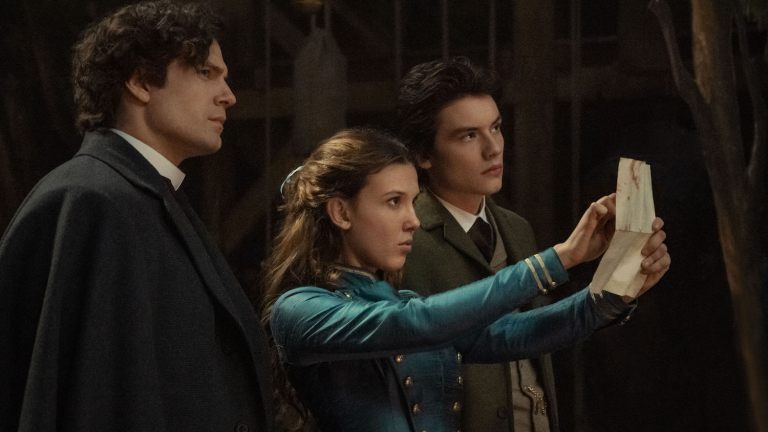Enola Holmes 2 Review: Millie Bobby Brown Ups the Game
Girl detective Enola Holmes (Millie Bobby Brown) sees her first official case draw from real history and reinterpret Sir Arthur Conan Doyle.

Tis she! Enola Holmes (Millie Bobby Brown), the whip-smart, socially awkward, fisticuffs-brandishing, disguise-swapping girl detective that Netflix introduced in a charming if overstuffed origin story in 2020. But with all the credit for solving that movie’s mystery going to her more established older brother, Sherlock (Henry Cavill), Enola’s sophomore outing in Enola Holmes 2 serves as something of a second debut: investigating a crime that no one else wants, the disappearance of a factory girl. As she tugs at loose threads, Enola unravels a larger conspiracy involving the upper and lower classes, typhus and the Treasury, and even a familiar nemesis of her brother’s. Despite Sherlock Holmes cautioning her against making the case about herself, it’s Enola’s personal investment—and especially her stumbles along the way—that make this second adventure so compelling.
Though the movie jumps right into the style of its predecessor, with Fleabag-inspired breaking of the fourth wall (director Harry Bradbeer returns to the helm), the filmmakers wisely establish early on that Enola only wants you to think that she has it together. Despite having enough money to open her own detective agency, she has no clients; despite saving the life of love interest Viscount Tewkesbury (Louis Partridge) and ensuring he can become a member of Parliament in the last movie, they haven’t really caught up since their awkward goodbye; and despite being reunited with her mother Eudoria (Helena Bonham Carter), the latter is still too busy blowing things up in the name of the suffragette movement to coddle her daughter.
Enola may not be alone, but she’s certainly lonely, which is part of why she leaps at the chance to reunite factory girl Bessie Chapman (Serrana Su-Ling Bliss) with her “found sister” Sarah, who has gone missing—presumably because of a boy. Used to being underestimated, Enola knows the answer isn’t that neat, and it’s only by walking in Sarah’s footsteps all across London that Enola will find the complete solution.
While Nancy Springer’s six-book YA series The Enola Holmes Mysteries provides the foundation for this fledgling movie franchise, returning screenwriter Jack Thorne (His Dark Materials) strikes out in an entirely different direction, plotwise. Enola’s latest mystery taps into the real-life history of the Matchgirls’ Strike of 1888, though Thorne does borrow some familiar elements from the books, including an upper-crust ally in Lady Cecily (Hannah Dodd) and such high-society intel as the language of flowers.
As Enola’s search crosses class lines from factory floors to seedy theaters, to social events of the season, it only emphasizes how much the youngest Holmes child’s uneven upbringing failed to prepare her to fit into modern society. This is most obvious in the teenage sleuth’s penchant for going undercover. Despite her brash charm and overconfidence, Enola is no chameleon: She can’t quite nail the humble factory girl manner (she’s hungry, but she’s not starving); then by contrast, she sticks out like a sore thumb at an elite ball due to her last-year fashion and—gasp—obliviousness regarding chaperones and other proper ladylike behavior.
The sequel wisely expands upon Enola’s experiences with code-switching, this time more complicated than donning a boy’s outfit (though they bring back that joke), and this time delivered by someone who will remind Enola of her own relative privilege: Ms. Mira Troy (Dune’s Sharon Duncan-Brewster), secretary to the head of the Treasury, but largely underestimated as an older, unmarried Black woman. Some of the best scenes involve Enola observing how others have fought to break the mold of what’s considered proper while still existing in those spaces.
All of which is to say, Enola is not too stubborn to ask for help when needed, be it from Sherlock—complete with sibling bickering—or from Tewkesbury, albeit with the caveat of calling him a nincompoop each time. Tewkesbury is a less compelling love interest in the second movie, and the sequel hardly justifies his existence, although their dynamic has an entertaining symmetry: He teaches her to dance, and she returns the favor by teaching him to fight. It is true that many a great woman can use a good man standing behind her.
At times it appears that the movie is not sure how much to ground its adolescent whimsy, nor how far to push its PG-13 rating. Murder is much more serious business than kidnapping, and Enola even gets herself wrongfully accused, but it’s unclear how dire those stakes are meant to be. Although it’s canonical enough for Inspector Lestrade (Adeel Akhtar) to be fairly oblivious to Enola’s business, it would have been fun to see him take a more active role, as opposed to meddling just enough to throw her off-balance because the plot required it. Later, a comedic scene with a drunk Sherlock begs the question, is this version of the Great Detective pre-addiction, or are they capping his vices at liquor?
But the most uneven depiction of tone is in the movie’s villain, Superintendent Grail (David Thewlis). Stalking Enola around corners with ominous taps of his cane, or sneering at her in plain sight when they cross paths at murder scenes, the corrupt policeman is perhaps too unsettling of an antagonist. He takes brutal delight in his chase of Enola (and, really, the entire Holmes clan), which makes the many scenes in which he corners her uncomfortable to watch. Perhaps the filmmakers realized this, because the showdowns with Grail often seesaw the opposite direction into the overly cartoonish. Then again, there is always need of a red herring.
Sherlock and Enola’s dynamic is note-perfect, to the point where you don’t even miss stick-in-the-mud foil Mycroft (Sam Claflin). Cut from the same cloth, these brilliant loners find small moments of connection taking care of each other but also recognizing the others’ limitations, and even masterminding some light matchmaking as required. (There are also a few clever nods toward the controversy with Holmes’ estate about this interpretation of Sherlock having feelings, with Enola commenting that “I like this version of you.”) Hopefully their relationship will remain a mainstay of future films.
While the first movie didn’t necessarily leave any loose threads, this one (like Enola herself) seems much more confident in the franchise’s continued existence, with an MCU-esque mid-credits scene to introduce someone very special to this world. Enola Holmes 2 has officially struck the match; let’s see how long it burns.
Enola Holmes 2 is streaming on Netflix now.
